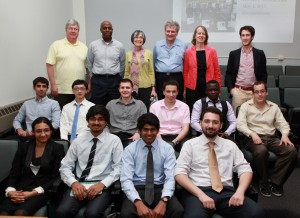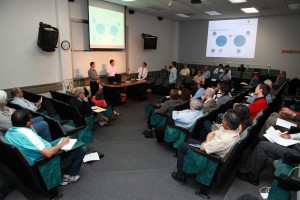 IIT Information Technology and Management students presented and demonstrated their Real-Time Communications projects to a crowd of communications professionals on May 1. Students were challenged to conduct research, and test and deploy solutions as part of the project-based learning approach at IIT School of Applied Technology. Unlike a final exam, these students had to provide a working system and defend it in front of a crowd of industry professionals—some with 30 years of experience.
IIT Information Technology and Management students presented and demonstrated their Real-Time Communications projects to a crowd of communications professionals on May 1. Students were challenged to conduct research, and test and deploy solutions as part of the project-based learning approach at IIT School of Applied Technology. Unlike a final exam, these students had to provide a working system and defend it in front of a crowd of industry professionals—some with 30 years of experience.
 Sponsors of the event included IIT School of Applied Technology, IEEE ComSoc and IEEE Fox Valley Subsection. Professor Carol Davids chaired the sessions and coordinated the student projects. The NG911 project was mentored by Joe Cusimano of Data-TelSystem Solutions. Several former IIT students also attended the event.
Sponsors of the event included IIT School of Applied Technology, IEEE ComSoc and IEEE Fox Valley Subsection. Professor Carol Davids chaired the sessions and coordinated the student projects. The NG911 project was mentored by Joe Cusimano of Data-TelSystem Solutions. Several former IIT students also attended the event.
- Emergency Services IP Network (ESInet): As more and more people use the Internet and the Web to communicate, the way that emergency calls are delivered to Public Service Answering Points needs to change. The new architecture is called the ESInet, and IIT’s Real-Time Communications (RTC) Lab now contains two, interconnected test beds that replicate the functioning of this Internet backbone to the emergency services communications network. This semester, the RTC students studied backup methods to ensure that when a signaling element on that backbone fails, the failure will be detected and a backup element will swing seamlessly into place to prevent an interruption of emergency service. They reported on solutions at the Internet level and application level.
Students: Kameswari Mantravadi, Vinoth Moongalam Thiyagarajan, Pragadeeswar Viswanathan Sagunthala
Mentor: Joe Cusimano, Data-Tel System Solutions, Inc. - SIP Performance Benchmarks: Today, many telecommunications systems are based on the Internet and in particular, on an Internet protocol called SIP (Session Initiation Protocol.) The vendors and service providers that deploy such systems need a way to measure the efficiency of the SIP servers on their networks. The RTC Lab has developed such a system and this semester was asked to use it to test the Acme Packet SBC 3800 commercial SIP server. Using the algorithm described in the Internet Engineering Task Force draft, draft-ietf-bmwg-sip-bench-meth-08, the students tested and reported the highest call rate that the system could support without errors as well as the maximum number of active calls that the system could support at that rate.
Students: Corentin Leman, Aitor Sanz Lopez, Michal Siuty and Tianjiao Sun - The WebRTC-based Projects: WebRTC is the name of a new collaborative effort by the World Wide Web Consortium and the IETF to standardize Web Browsers and network protocols to allow people to make audio/video calls and more directly from browser to browser. The RTC Lab has already developed a Web-conferencing service based on these rapidly changing developments. This semester the WebRTC student team worked to develop two new WebRTC-based applications as well as a test bed on which to measure the network resources consumed by these applications. The applications which are being developed are a system to deliver closed caption text along with the audio/video conference, and a proto-type method for making calls to 911 directly from the browser. Annie Ross reported on the closed caption progress while Jorge Lopez Herguido described the 911 development effort. Frederic Adam provided the WebRTC overview and the current and future design of the Network Transport and Performance (NTAP) test bed.
Students: Frederic Adam, Jorge Lopez Herguido and Annie Ross
Voice Over IIT: The RTC Lab is host to a SIP-based service called Voice over IIT (VoIIT.) It uses the open-source Kamailio SIP proxy for routing calls and registering users, and the Asterisk IP-PBX as an application server for things like voicemail and conference calls. This semester the student team added several new features to the basic SIP-based service that the VoIIT system provides, including video calling and a WebRTC interface. The team also studied two different ways to link end-users using different systems—routing based on the Domain Name System service vs. routing based on a configured peering relationship between the two domains.
Students: Peter Doherty, Robert Ersery and Frank Lajos - Media Performance Metrics: When the quality of the streaming media you receive on your smartphone is not great, how does a network service provider determine if its network is at fault? The student team is developing a metric to represent the quality of the streaming media as it traverses a given network. Service providers can use such a metric to determine how well their network is handling media streams. The students reported on the test bed that they created and the methods they used for controlling their experiments. They described the data they collected, their analysis of the data and the next steps they will take as they develop of metric based on these data.
Students: A. Nafiu and Elias Yousef
 IIT has two Real-Time Communications labs, one at the Rice Campus in Wheaton and the other at Main Campus. Learn more on the RTC lab website.
IIT has two Real-Time Communications labs, one at the Rice Campus in Wheaton and the other at Main Campus. Learn more on the RTC lab website.
IIT also host the Real-Time Communication Conference and Expo.
See pictures from the event on the IIT School of Applied Technology Facebook page.
